
Field Report Delevan Blind #12
by Darrick Baker
On November 7 Bob, Kevin and I picked blind #12 with our #22 reservation at Delevan Wildlife Refuge. Blind 12 in the past has been a very good hole for mallards. This pond has a lot of good tule clusters for cover, and not too much open water which is more ideal for those favored puddle ducks. This blind turned out to produce well without wind or any other type of weather. The birds that wanted to be there came in at all costs. I was watching mallards and pintail coming into the decoys like it was opening day. Around 10:00 a.m. all the ducks stopped moving, it was almost like someone flipped a switch. At about noon, with 10 ducks, we decided to pick up and call it a day.
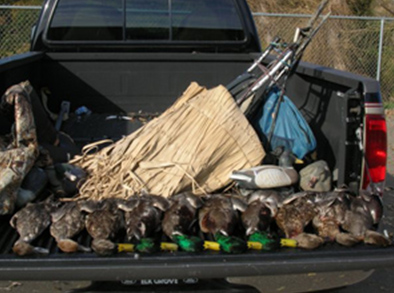
Field Report
BY BILL MAYS
Delevan, Colusa, Little Dry Creek, and Sacramento have been the hot refuge’s the last few weeks according to various reports from successful refuge hunters. Rice duck club hunters have been spotty. If the hunters have the weather, they are scratching out a few ducks and spec geese. Brett Crow and Curt Wilson and another hunter hunted on a private club near Rancho Esquan, shot three limits of mallards, and didn’t start hunting until 1:00 o’clock.
Field Report Blind 24: Delevan
BY DARRICK BAKER
On November 21, my friend Lance Meyer invited Keith Smith and I to come along to Delevan on a number two reservation. This was an opportunity I could not pass up; I even had to get someone to cover my shift at work just so that I could go. We were not only blessed with a number two reservation, but it was also one of the first hunt days of the season with a good fog. A good fog can help alter the duck’s normal routine and their visibility, which generally leads them to the closed zone.
Reservation number one took blind one, so we took the next best, blind number twenty-four. Blind twenty-four is a bit of a hike, over a mile, but it is an excellent blind. This pond has fair Tule cover along with some open water. Blind twenty-four sits right on the closed zone which gives you the first chance at the ducks before they get shot at and gain altitude.
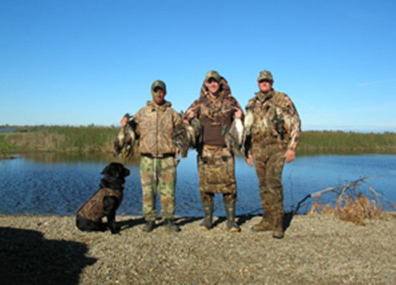
DELEVAN BLIND #24—Field Reporter Darrick Baker and friends left to right Keith Smith, Lance Meyer, Darrick Baker, and the dogs name is Avery, continue to have success at Delevan Refuge.
The refuge was roaring with gunshots in the morning, mostly coming from the jam packed free roam area. Our morning started with the typical eighty mile an hour teal flyby’s that you can barely even see, let alone get a shot off. The fog made it even harder on those quick little ducks; one second there is no birds, and then, all of a sudden, you turn your head and there is a group of ducks setting up in the decoys. Although the teal were abundant, they are fast and we were slow; besides, we were hoping for larger birds.
We had a few good hours of shooting until around 10:00 a.m., the fog lifted, and it slowed way down. At this time most of us only had about four ducks apiece, and not too many shells. We could have shot a lot of spoonies throughout the day, but we tried to hold out for other species. As for myself, I “got me some.” I shot two drake spoonies just to help the population control.
Our day ended at about noon, when the birds were done! Between missing birds, and just hearing their wings pass over our heads, we had plenty of chances to get three limits. We left with 17 ducks, one of them being a banded hen Gadwall. As an overall, the refuge shot a 4-bird average, which is beyond good. This was an excellent hunt with good friends, and I can’t wait to get back out.
Field Report
BY BRIAN WELLS
Brian Wells of Roseville and his partner shot some ducks on geese on their duck club off Hwy 99 near Sacramento. “The ducks and geese finally found our duck club,” said Wells. “It took 2 weeks for the birds to find our newly flooded fields.”
Field Report-Klamath Basin
BY JIM SZEMENYEI
The Klamath Basin is beginning to freeze up. Wild Times Guide Jim Szemenyei said, the Klamath Basin is beginning to freeze up pretty good.” When the basin first freezes up the hunting is pretty slow, but then within a few days the hunting will pick back up.”
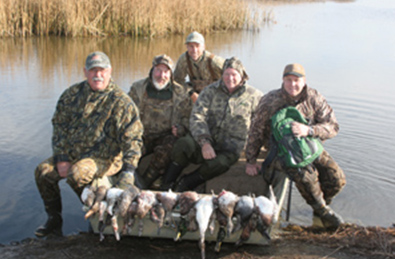
Wild Times Guide Jim Szmenyei and clients the first week in Nov.
Field Report-Klamath Basin
BY BILL MAYS
This writer hunted for a week, the first week in November and out of the 7 days, our hunting party only had 3 good days and they were weather related, no weather, no ducks.
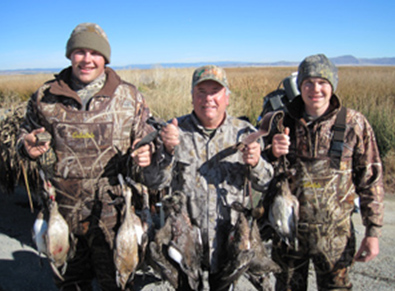
Left to right, Billy Evans, Bill Mays, and Steven Evans hunted Lower Klamath the first week in Nov.
Field Report—Eagle Lake
BY RICK KENNEDY
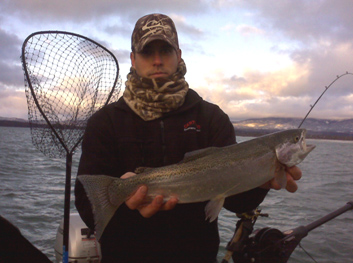
Duck hunting is slow but Steve Brown displays a quality rainbow taken on a Tight Lines Cast & Blast with Rick Kennedy.
Pheasant Hunting
The pheasant season opener was also spotty. For the last couple of years the pheasant hunting has been going downhill. There are some theories going around that blame the mosquito abatement program for the poor pheasant hatches. Young pheasants need the protein from bugs to survive the first couple days of their lives. Without the bugs the chicks will not survive.
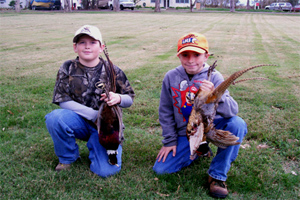
Eleven-year-old Brock Riggs of Turlock and nine-year-old Jacob Chappell of Dixon had some fun and success at the Grizzly Island Youth Hunt on opening weekend. The young hunters jumped up 13 roosters in the field they were hunting.
The Grizzly Island Junior Pheasant Hunt
The Grizzly Island Junior Pheasant Hunt
BY JR. FIELD REPORTER BROCK RIGGS
GRIZZLY ISLAND—Last week I went on a junior pheasant hunt on Grizzly Island. When we got there, we parked and then got ready. After I got my orange vest on, they gave me safety glasses to protect my eyes and gave us all an orientation to make sure we would be safe and to make sure we knew the rules of the hunt. Then my friend Jacob Chappell, his friend Mark and I went to the field we were assigned and once we got there, we started walking up the field, spaced out in a line.
My dad and I were on the left, Jacob and his dad in the middle, and Mark and his dad on the right. My dad spotted a quad track and we started walking it. Our dog got on the scent of a bird and I saw the colorful head of a pheasant poke out of the brush. Koby, our black Labrador Retriever, ran after it, but it started running. I got my gun up and clicked off the safety right before the bird jumped. It got about forty-five yards before I shot my 20 gauge. When I shot, the wings folded up and it fell to the ground. When our dog brought it back, we noticed that both wings were broken and it also got shot in the head! The next bird jumped behind Jacob and he didn’t get the safety off in time. I missed him too. The next bird had jumped in between Jacob and I. It had surprised Jacob, and it flew toward me, so he didn’t shoot. After it passed in front of me, I lead it and shot. This one fluttered to the ground still alive but the dogs had no problem catching it. After that, because they were only allowing us two birds per shooter, I walked with them to help jump birds for Jacob and Mark.
We had a great time learning how to hunt pheasants and even saw a herd of Tule Elk up close! I am thankful that they have this kind of hunt for junior hunters and hope I get another chance to do this soon!
GRIZZLE ISLAND—Last week I went on a junior pheasant hunt on Grizzly Island. When we got there, we parked and then got ready. After I got my orange vest on, they gave me safety glasses to protect my eyes and gave us all an orientation to make sure we would be safe and to make sure we knew the rules of the hunt. Then my friend Jacob Chappell, his friend Mark and I went to the field we were assigned and once we got there, we started walking up the field, spaced out in a line.
My dad and I were on the left, Jacob and his dad in the middle, and Mark and his dad on the right. My dad spotted a quad track and we started walking it. Our dog got on the scent of a bird and I saw the colorful head of a pheasant poke out of the brush. Koby, our black Labrador Retriever, ran after it, but it started running. I got my gun up and clicked off the safety right before the bird jumped. It got about forty-five yards before I shot my 20 gauge. When I shot, the wings folded up and it fell to the ground. When our dog brought it back, we noticed that both wings were broken and it also got shot in the head! The next bird jumped behind Jacob and he didn’t get the safety off in time. I missed him too. The next bird had jumped in between Jacob and I. It had surprised Jacob, and it flew toward me, so he didn’t shoot. After it passed in front of me, I lead it and shot. This one fluttered to the ground still alive but the dogs had no problem catching it. After that, because they were only allowing us two birds per shooter, I walked with them to help jump birds for Jacob and Mark.
We had a great time learning how to hunt pheasants and even saw a herd of Tule Elk up close! I am thankful that they have this kind of hunt for junior hunters and hope I get another chance to do this soon.